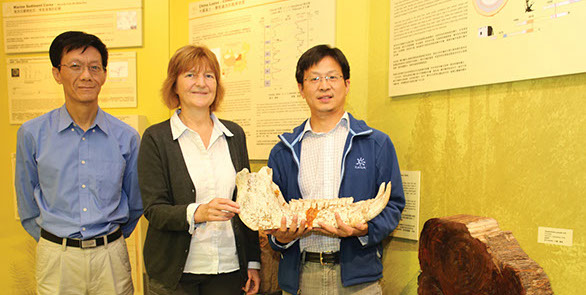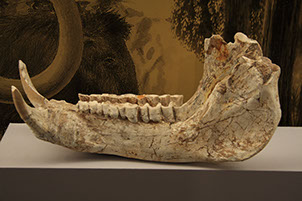Past, present, future
An exhibition aims to predict future climate change by looking at the past.
Climate change affects our daily lives and is therefore a hot topic these days. Seeking an understanding of the extent of the present climate change was part of the reasoning behind the new permanent exhibition, Cenozoic Climate Change, which has been added to the existing Earth Evolution Gallery at HKU’s Stephen Hui Geological Museum.
Curator and lecturer in Earth Sciences Dr Petra Bach explained: “Everyone is talking about climate change evidenced by rising global temperatures, sea levels and concentrations in greenhouse gases, but little is said about its relationship with climate variations in the geological past. For Earth scientists the context with the geological past is an essential part of the conversation.”
Displayed climate data demonstrates to visitors that 50 million years ago Earth’s temperature was actually hotter than today – about 10 to 15 degrees Celsius higher, with life thriving on an ice-free Earth. More recently during the Pliocene epoch (2.3 to 5.6 million years ago), just before the emergence of our genus Homo, temperatures were 2 degrees higher than today. “It is very important to study such periods of the Earth’s history to be able to predict the future,” said Dr Bach.
Opened on Earth Day this year, the Cenozoic Climate Change exhibition spans the last
65 million years of Earth history – from the extinction of the dinosaurs to the present day. Dr Bach put the exhibition together in collaboration with two climate change experts from the Department of Earth Sciences, Professor Zong Yongqiang and Dr Liu Zhonghui.
Scientists have no way of directly measuring past levels of atmospheric temperature or carbon dioxide (CO2) content. But a number of different indirect methods, called proxies, lead them to estimate the temperatures and CO2 contents in ancient atmospheres.
One part of the exhibition displays a range of such paleoclimate ‘proxies’ including marine micro-fossils from deep-sea sediment cores viewable through a magnifier, a marine sediment core, a replica of an ice core as well as some beautiful 3,000-year-old tree rings.
“These proxies act like natural recorders of climate variability in the geological past addressing climate history beyond the limited instrumental weather records,” said Dr Bach. “They provide paleoclimate data that gives us a much needed baseline of natural climate variability against which human-induced climate change can be assessed. For example, ice core records provide the primary evidence that modern greenhouse gas concentration lies far outside the natural variability of the last 800,000 years.”
Hong Kong’s climate history is represented by a preserved core of marine mud collected off Lantau Island. The lower red section was deposited in the last interglacial about 125,000 years ago, and the upper section was deposited during the past 7,000 years, i.e. the current interglacial.
There are also samples of dust deposits from the China Loess Plateau, dating back about 100,000 years. All these exhibits show the scientific methods used to measure and help scientists reconstruct global and regional climate changes over the last 65 million years.
“The typical geologically young and undisturbed proxies from the Cenozoic, the most recent geological era, have the advantage of providing a continuous climate record,” said Dr Bach. “It is the combination of different types of proxy records covering various time scales that help us to reconstruct detailed climate variations going back millions of years and revealing multiple episodes of gradual and rapid climate changes.

Curator of the Stephen Hui Geological Museum Dr Petra Bach (centre) and two climate change experts of the Department of Earth Sciences Professor Zong Yongqiang (left) and Dr Liu Zhonghui (right).

![]() Everyone is talking about climate
Everyone is talking about climate
change evidenced by rising global temperatures, sea levels and concentrations
in greenhouse gases, but little is said about
its relationship with climate variations in
the geological past. ![]()
Dr Petra Bach
Orbital eccentricities
“Climate is a very complex system. The most vital factor is the energy provided by our sun, of course, but it too fluctuates because of solar activities and periodical changes in the Earth’s orbit, defined in the Milankovitch cycles, providing a predictable pacing of climate change,” she said. “But it is the complicated interaction between processes in the interconnected Earth systems of the atmosphere, hydrosphere, geosphere and biosphere and their feedbacks that makes climate change a complex phenomenon.”
The focus of the second part of the exhibition is a large 3D graph, running the length of a display and showing temperature fluctuations from 65 million years ago to today.
“Beside a continuous long-term trend of climate change from warm conditions with ice-free poles 65 million years ago to present-day cooler conditions, there are also short-term abrupt climate changes that occurred before humans appeared, so we can’t be blamed for this,” said Dr Bach. “They could have been caused by volcanic eruptions, fluctuations in ocean currents as continental plates formed or moved and mountains formed.”
Today, however, human activities seem to play a part. “In my lifetime the world population has doubled and CO2 levels have soared,” she said. “Paleoclimate proxy research reveals that in only the last 300 years since the beginning of the Industrial Revolution, atmospheric CO2 levels rose to an extent that exceeds by far the natural variations of the last 650,000 years. Such abrupt climate change may force our climate system to respond in abrupt and unexpected ways that humans and natural systems may have difficulties adapting to it.”

Tree rings of a 3,000-year-old fossil wood of a pine tree (Glyptostrobus pensilis) from the Pearl River Delta reveal past climatic conditions.

Fossil from an ancient rhinoceros paradise in Linxia basin, north of the Tibetan Plateau.
Back



